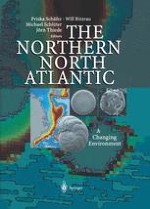2001 | OriginalPaper | Chapter
Patterns and Determinants of the Distribution and Structure of Benthic Faunal Assemblages in the Northern North Atlantic
Authors : Dieter Piepenburg, Angelika Brandt, Karen von Juterzenka, Michaela Mayer, Klaus Schnack, Dan Seiler, Ursula Witte, Michael Spindler
Published in: The Northern North Atlantic
Publisher: Springer Berlin Heidelberg
Included in: Professional Book Archive
Activate our intelligent search to find suitable subject content or patents.
Select sections of text to find matching patents with Artificial Intelligence. powered by
Select sections of text to find additional relevant content using AI-assisted search. powered by
The distribution and structure of zoobenthic communities have been investigated in the northern North Atlantic. The principal goal of these studies is to assess the degree to which benthic community patterns depend on and/ or mediate carbon flux between the pelagic and benthic realms, as well as between seabed, sediment-water interface and benthic boundary layer. A common rationale is that these patterns integrate the impact of environmental factors over longer periods of time and reflect relatively long-lasting or predictably recurrent environmental states, thus providing clues to the relative significance of potential community determinants on a time scale of months to years. Since 1992, several meso-scale field studies have been carried out in three regions at the East Greenland continental margin between 68° N and 81° N at water depths ranging from 40 to 3,700 m. A suite of sampling methods was employed (corers, trawls, seabed imaging) to adequately probe various benthic community fractions, such as foraminifers, poriferans, macrobenthic endofauna, peracarid crustaceans and megabenthic epifauna.A depth zonation in the faunal composition, accompanied by a shift in the predominance of different feeding types and a significant decline in biomass and abundance by as much as two and three orders of magnitude was the most conspicuous general pattern detected. However, in terms of species richness, no common trend for water depth or latitude was perceivable. The general depth zonation of the macrobenthos as well as the spatial concordance of high macrobenthic abundance and biomass with relatively productive hydrographic zones, such as marginal ice zones, polynyas and anti-cyclonic gyres, provide evidence for the importance of water column processes and, hence, for subsequent food availability as major determinants for benthic assemblages and the significance of pelago -benthic coupling in the study area in general. However, for megafaunal species such as echinoderms, community patterns on a 10-1an scale and the dispersion of organisms on a 100-m scale, are best explained by seafloor properties. There is no evidence of direct pelago-benthic coupling, irrespective of water depth. These contrasting findings emphasize that the relative importance of potential community determinants can change with both spatial scale and life traits, e.g. body size, mobility and feeding ecology, of the organisms considered.
